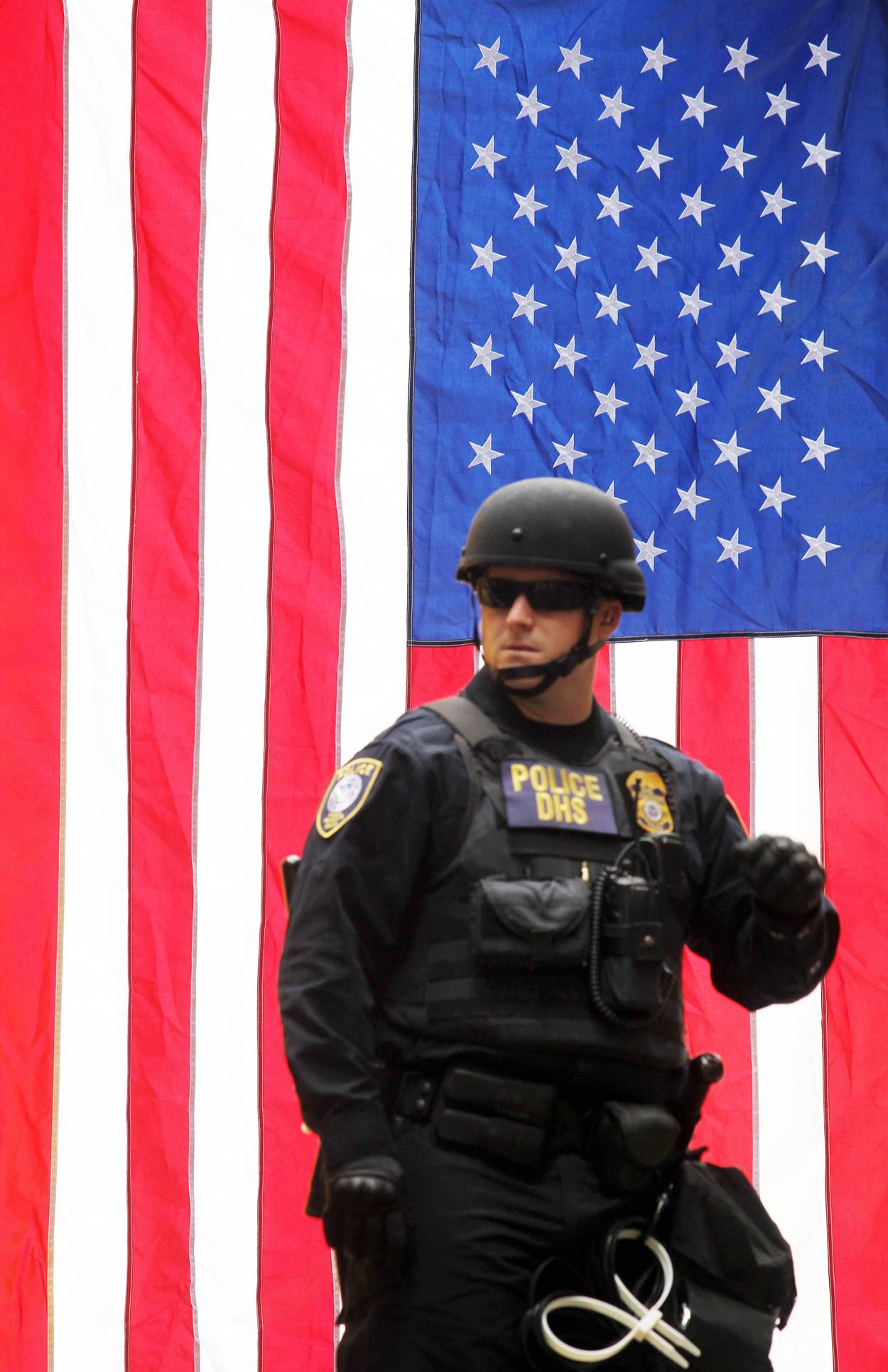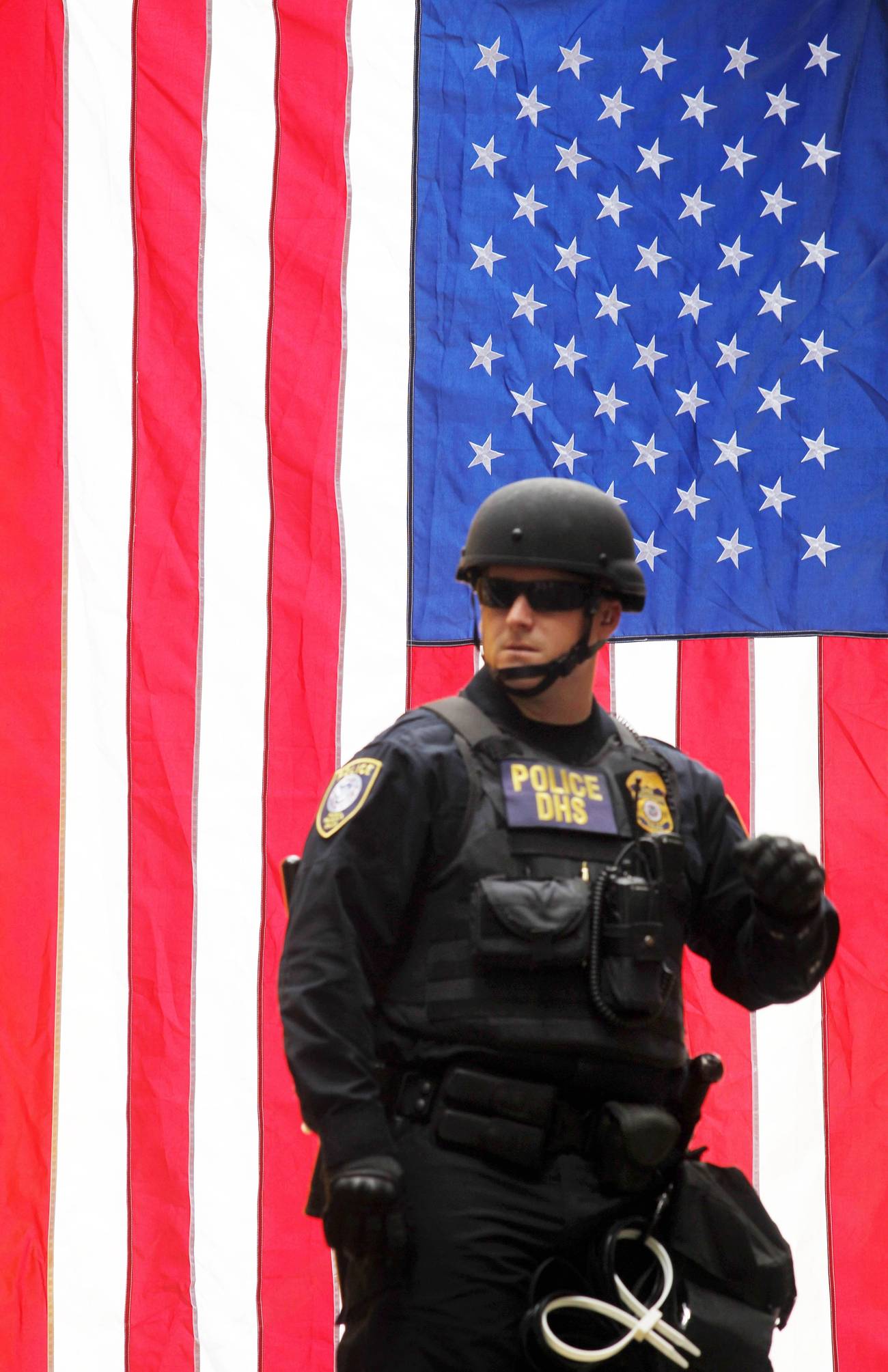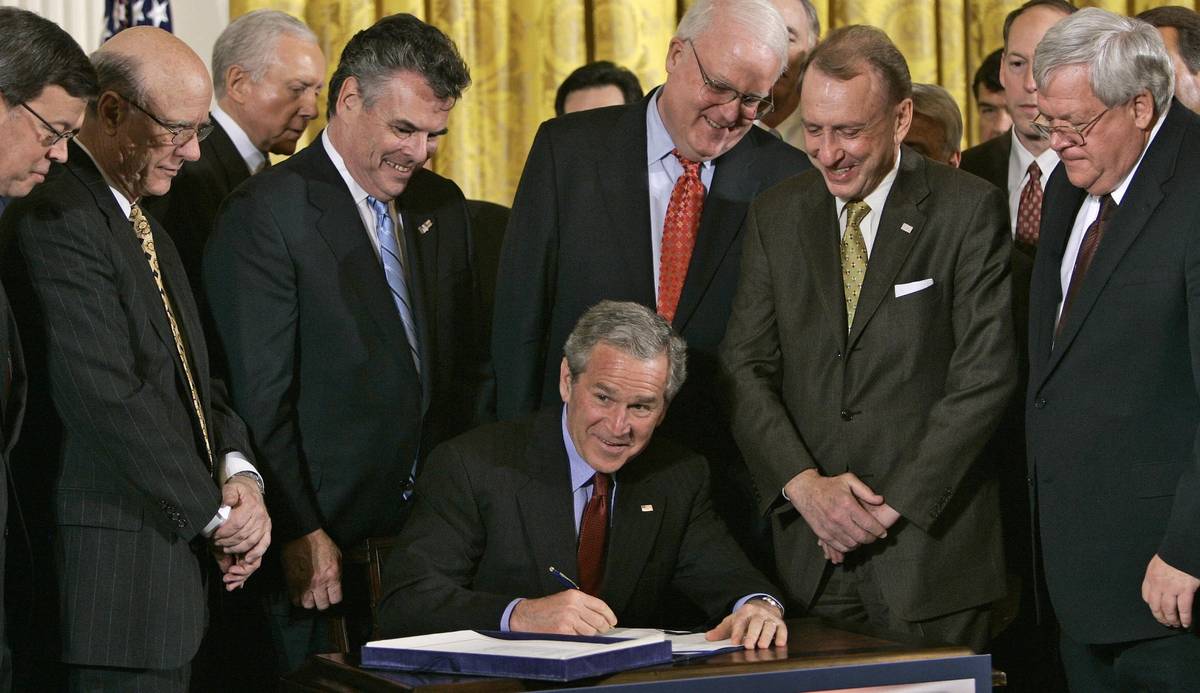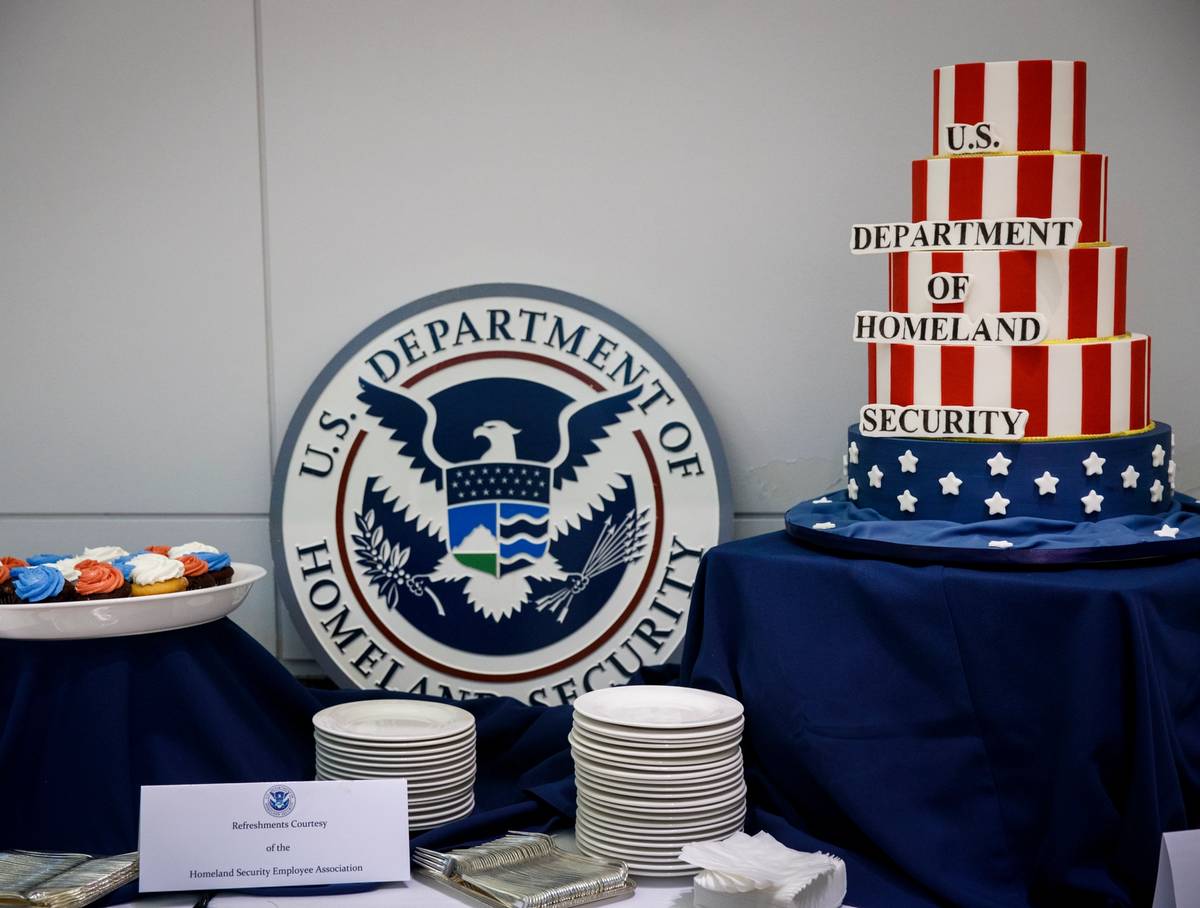The Normalization of the Post-Sept. 11 Regime
Nearing the 20th anniversary of the USA Patriot Act, how did laws ostensibly structured to protect Americans from threats from abroad come to reimagine the legal basis for our freedoms at home?




Although it seems like a decade ago, given intervening large events, the final debate of the 2020 presidential campaign, between President Donald Trump and former Vice President Joe Biden, was ostensibly dedicated to foreign policy and national security. And yet, at no point during the 96-minute affair last Oct. 22 did anyone mention Afghanistan or Iraq (or any of the other ongoing overseas deployments of U.S. troops); Guantanamo (where 40 men continue to linger in what increasingly appears to be perpetual detention); or even the controversial scope of U.S. surveillance authorities here at home. Yet the key counterterrorism authorities that Congress enacted after the Sept. 11 attacks remain very much on the books—and have become a regular part of many of our lives, woven into the fabric of our laws and how the federal government responds to what it deems to be a threat or a crisis.
For example, when the Department of Defense requested National Guard troops from 11 states to help respond to unrest in Washington, D.C., last June, it did so under an obscure provision Congress adopted in a 2006 defense spending bill that provides a backdoor around the Posse Comitatus Act (which otherwise limits the use of the military for domestic law enforcement). When a Lebanese-born Palestinian convicted of terrorism offenses in 2007 finished serving his prison sentence last year and was set to be released, the government instead continued to detain him under a never-before-used civil detention provision of the USA Patriot Act—enacted nearly 20 years ago in October 2001. And those are just examples that we know about. There also continues to be significant concern among civil libertarians about the secret surveillance Congress authorized in a 2008 amendment to the Foreign Intelligence Surveillance Act (FISA)—under which Americans can’t be “targeted,” but can have their communications “incidentally” collected in far more circumstances than most appreciate.
How did laws ostensibly structured to protect Americans from threats from abroad come to restructure the legal basis for our freedoms at home? The answer begins with America’s response to Sept. 11.
The conventional wisdom, largely codified in the 9/11 Commission Report, is that the Sept. 11 attacks were the culmination of a series of catastrophic intelligence failures combined with the insufficient prosecutorial authorities provided by pre-Sept. 11 federal criminal law. These domestic shortcomings came alongside the fraught geopolitics of Central Asia, in which al-Qaida had been able to create a stronghold within Afghanistan while the Taliban, at best, looked the other way.
Congress responded with double-barreled statutes: the Authorization for the Use of Military Force (AUMF), signed into law by President George W. Bush on Sept. 18, 2001, and the preposterously named Uniting and Strengthening America by Providing Appropriate Tools Required to Intercept and Obstruct Terrorism Act, enacted just over five weeks later. The AUMF opened the door to offensive military operations in Afghanistan and elsewhere to eliminate the threat posed by al-Qaida; and the USA Patriot Act provided additional surveillance and prosecutorial authorities intended to help deter, prevent, and punish transnational terrorism on the home front. Famously, only one member of Congress voted against the AUMF. And although there were far louder civil liberties objections to at least some parts of the USA Patriot Act, the bulk of it got through Congress largely unscathed. At least initially, then, it looked like Congress was to play a leading role in shaping the contours of post-Sept. 11 counterterrorism policy.
That impression didn’t last. On Nov. 13, 2001, President Bush promulgated a “military order” relating to the detention, interrogation, and military prosecution of “enemy combatants”—detainees captured as part of the United States’ military operations—relying heavily on his inherent constitutional authority as commander in chief. Shortly thereafter, the government began sending noncitizens picked up in Afghanistan and elsewhere to the U.S. naval base in Guantanamo Bay and, as we now know, to an array of secret CIA “black sites” across at least three continents.

Instead of going back to Congress for specific authority for any of these initiatives, the Bush administration came to increasingly rely upon novel claims of executive authority—even in the face of statutes seeming to restrict it. Thus, in a series of memos from the Justice Department’s Office of Legal Counsel, the government claimed authority to torture detainees; to try them in irregular courts; to conduct domestic surveillance without warrants; and so on, not because Congress had authorized such measures, but because statutes seeming to prohibit them were themselves unconstitutional infringements of the president’s inherent and indefeasible constitutional authority. Even more troublingly, the Bush administration also began pushing claims that its legal theories, and the measures they supported, were not properly subject to judicial review.
In a series of four increasingly aggressive decisions in June 2004, June 2006, and June 2008, the Supreme Court pushed back. In the Hamdi and Rasul rulings in 2004, the justices made clear that U.S. courthouse doors were open to detainees seeking to challenge the legality of their detention. In the Hamdan decision in 2006, the court threw out President Bush’s first attempt to use military commissions to try the Guantánamo detainees largely because Congress hadn’t authorized them. In the process, the justices also clarified that at least part of the Geneva Conventions applied to the United States’ conflict with al-Qaida—a holding that, among other things, sounded the death knell for the CIA interrogation program. And when Congress responded to that ruling by trying to cut the courts out of Guantanamo cases altogether, the Supreme Court responded in 2008 by holding that the putative removal of its jurisdiction was unconstitutional.
Critically, though, none of these rulings repudiated the underlying policies at issue. Indeed, when courts finally began to reach the merits of some of these cases after 2008, the government won at least as many times as it lost—and, as importantly, received the imprimatur of legitimacy that came with judicial approval of the core detention program. Whereas the early years of the Bush administration had been marked by fear that the other branches might stand in the way of the government’s most important counterterrorism initiatives, by 2006, conservative scholars were arguing that this had been a strategic error—and that a healthy interbranch dialogue would not only avoid the earlier pitfalls, but it would put U.S. counterterrorism policies on firmer legal footing when the same courts the government had been avoiding started ruling for the government on the merits. As to Guantanamo, at least, they were clearly correct.
At almost the same time, the Bush administration also went back to Congress on surveillance reform—pushing through the 2008 FISA Amendments Act, which radically transformed (and expanded) the government’s secret spying powers. The principal innovation, known as “Section 702,” opened the door to programmatic surveillance without individualized suspicion so long as the targets were noncitizens outside the United States—even if the government knows that its collection methods will inevitably, if incidentally, also capture the content of U.S. persons’ communications. Shortly before President Barack Obama’s inauguration in January 2009, the Bush administration quietly repudiated most of the earlier OLC memorandums resting on broad claims of inherent constitutional authority. The statutes, it turns out, had been more than sufficient.
What is perhaps most surprising in retrospect is how little has changed since Jan. 20, 2009—when President Obama was sworn in, replacing President Bush. Then-Sen. Obama had been highly critical of many of the Bush administration’s constitutional arguments; candidate Obama had promised reforms across an array of counterterrorism initiatives; and one of President Obama’s first official acts was signing an executive order to “close Guantanamo.” As time went on, though, it became clear that almost all of the changes to U.S. counterterrorism policies were to the legal theories undergirding them, rather than their bottom lines.
Rather than abandoning the military commissions President Bush had recommitted to after the 2006 Supreme Court decision invalidating the first effort, Obama pushed for modest procedural reforms and a renewed push that Congress enacted in the Military Commissions Act of 2009. Obama was also painfully slow in transferring other detainees out of Guantanamo (which would come back to haunt him when the political tides shifted and Congress began blocking transfers in 2011).

Perhaps most significantly, his administration continued to vigorously defend the government’s newfound surveillance policies in court. Even when Democrats controlled both chambers of Congress, there was no effort to undo any of the major post-Sept. 11 reforms. After his reelection, Obama would begin to argue for paring back the AUMF, but it was too little, too late.
Worse still, when Attorney General Eric Holder publicly floated the idea of moving the most important terrorism trials to civilian courts, including the case against the five so-called “9/11 defendants,” it was the White House (under mounting political pressure) that pushed back—instructing Holder to stand down. The military commission trial of the same defendants is still mired in pretrial proceedings—and may soon be presided over by a sixth different judge since August 2018.
Whether correlation or causation, Obama’s election came alongside a fundamental shift in the role of the courts in post-Sept. 11 cases, as well. As opposed to the aggressiveness that marked the Supreme Court’s role in challenges to the Bush administration’s policies, the court became far more passive in counterterrorism cases beginning in 2009. In the few cases it heard, it consistently ruled for the government—whether because the underlying policy was lawful or because some procedural obstacle prevented the courts from reaching the issue. Justice Kennedy—who had voted against the Bush administration in all four of the major rulings in the mid-2000s—now sided with the government in an array of cases.
Between 2010 and 2013, the justices rejected a constitutional challenge to those USA Patriot Act provisions that criminalized advocacy on behalf of foreign terrorist organizations as a form of “material support”; they upheld a nakedly pretextual use of a statute authorizing the detention of “material witnesses” to detain a University of Idaho football player who the government had no intention of using as a witness to anything; and they held that the constitutionality of the 2008 surveillance reform could only be challenged by someone who could prove that interception of their communications under that authority was “certainly impending”—a rather tall order for a program that is entirely secret. In each of these cases, Justice Kennedy sided with the Obama administration. And for each of these rulings, the court refused to even hear additional cases in which lower courts had turned away challenges to post-Sept. 11 counterterrorism policies. Thus, as Sept. 11 retreated further and further into the rearview mirror, the policies it provoked, which were putatively tied to the urgency of meeting the threat, ironically fared better in court.
So it was that when the Obama administration used military force to intentionally target and kill a U.S. citizen—Anwar al-Awlaki—the courts had virtually nothing to say. And when Edward Snowden revealed the existence of a series of legally dubious government surveillance programs, the most aggressive judicial response was a ruling that one of those programs had exceeded the terms of the statute purportedly authorizing it. Even the “reforms” that Snowden’s disclosures provoked Congress into pursuing (including increasing the transparency and adversarialness of proceedings before the FISA Court) were heavily watered down before they were enacted in 2015. The Obama administration may have found less dramatic and controversial ways to defend the more controversial aspects of U.S. counterterrorism policy, but the critical point is that, in most respects, it defended them nonetheless—after America largely withdrew from Iraq, and the threats that had ostensibly made these policies necessary had largely receded. The combination of the Obama administration’s approach and the courts’ acquiescence effectively normalized what might previously have been framed as abnormal.
When President Trump came to office in 2017, it was easy enough for him to simply continue as before. Even as his administration returned to some of the more ominous legal theories that had marked the Bush administration’s approach, it was hard for the American public to see any difference on the ground—assuming it even looked in the first place. When Trump began to use some of the post-Sept. 11 authorities to push back against domestic protests, as in Portland and D.C., a common response to critics was that those authorities “had been around for a while.” Of the many policy proposals President-elect Biden has outlined, none of them includes reforms to any of these statutes—or to post-Sept. 11 national security policies more generally.
In 1944, when the Supreme Court infamously upheld the internment of Japanese Americans during World War II, three justices dissented. Two—Justices Owen Roberts and Frank Murphy—focused on the myriad problems with the policy itself. But Justice Robert Jackson, former attorney general and soon to be lead prosecutor at the Nuremberg war crimes tribunal, directed most of his opprobrium at his colleagues in the majority. As he put it, a “military order, however unconstitutional, is not apt to last longer than the military emergency. ... But once a judicial opinion rationalizes such an order to show that it conforms to the Constitution, or rather rationalizes the Constitution to show that the Constitution sanctions such an order, the Court for all time has validated” the harm inflicted in the name of expediency. “The principle then lies about,” Jackson famously concluded, “like a loaded weapon ready for the hand of any authority that can bring forward a plausible claim of an urgent need. Every repetition imbeds that principle more deeply in our law and thinking and expands it to new purposes.”
Stephen I. Vladeck is the Charles Alan Wright Chair in Federal Courts at the University of Texas School of Law, and co-hosts the National Security Law Podcast. His Twitter feed is @steve_vladeck.